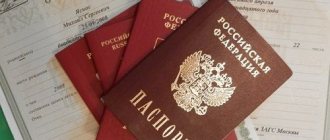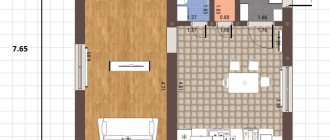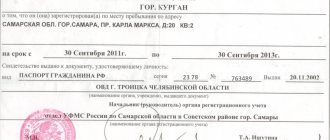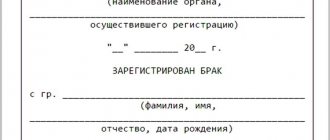What needs to be indicated, filling rules
Like any other document, the deed of cohabitation must be correctly drawn up, that is, it must contain all the necessary elements in order for it to have legal force. The document in question must contain the following information:
- The name is “cohabitation deed.”
- Information about residents (full name, passport details).
- Information about neighbors participating in the preparation and confirmation of this act.
- Written explanations from neighbors, the presence of things, documents confirming the residence of one person with another.
- Address of the apartment where the inspection took place.
- Attachment, if there are documents relevant to the case.
- Date and signatures of neighbors and inspector.
See samples below.
Who compiles and where to submit
The owner of the premises, his neighbors or employees of the management company can draw up an act of cohabitation. However, when drawing up a deed, the owner or neighbors will need to have the document certified by the management company, but it is also possible to have the deed certified by a notary.
Documents are prepared, as a rule, for submission to any authorities where this or that confirmation is required.
The deed can be used to confirm cohabitation with any government authorities where it is required.
For example, according to paragraph “o” of Article 54 of the Order of the Ministry of Health and Social Development of Russia dated December 23, 2009 “On approval of the Procedure and conditions for the appointment and payment of state benefits to citizens with children,” in order to receive a child benefit, you will need a document confirming the child’s cohabitation with one of the parents. The corresponding act may just be such a document.
This document will also help when receiving alimony.
The actual place of residence is
Despite the fact that the institution of registration in the Russian Federation has long been abolished, citizens of the Russian Federation are not exempt from the need to notify government authorities of their place of residence.
In addition to the registration address, there are two more concepts: place of residence and place of stay. Despite the similarity of names, all 3 concepts have significant differences from each other and differ in legal terms. We’ll talk further about what it is: actual residential address.
Dear readers! Our articles talk about typical ways to resolve legal issues, but each case is unique.
If you want to find out how to solve your particular problem, please contact the online consultant form on the right or call the free consultation numbers:
—>
You can find out what documents are needed for registration in a private house from our article.
Registration address
The registration address is indicated in the general passport and means the residential premises in which the person lives .
Registration address is an officially confirmed address about which a citizen notifies government authorities.
Registration can take place at the place of residence or at the place of stay, and registration can be permanent (place of residence) or temporary (place of stay).
Should they match?
The situation when the addresses of residence and registration differ is very common, although by law the registration and place of residence of a citizen must match .
If a citizen permanently resides at another address, he must register permanently at this address.
However, in reality, the registration address and place of actual residence often do not coincide , since citizens ignore the need to notify government authorities about a change of place of residence.
In such cases, you should be aware that a fine may be charged for staying without permanent or temporary registration.
Place of stay
Place of residence means a residential premises or institution in which a citizen lives on a temporary basis .
Places of stay include various hotel-type institutions, sanatoriums, hospitals and hospitals, places of detention or other premises. Places of stay also include premises rented by a citizen, if the rental period does not exceed 90 days.
What liability is provided by law for the disclosure of personal data? Find out the answer right now.
Difference from place of residence
The place of stay differs from the place of residence in character and timing.
You can live at the place of residence on a temporary basis ; the place of residence, on the contrary, implies permanent residence at this address.
The law also establishes differences in the required registration periods. At the place of stay, registration must be completed within 90 days from the time of arrival, at the place of residence - within 7 days.
We can say that the place of residence is permanent, and the place of stay is temporary residence.
How to confirm actual residence?
Confirmation of the address of actual residence is necessary in many cases, for example, to exercise social rights (payment of various benefits, issuance of a health insurance policy, etc.).
Since the exercise of such rights is possible only in one place, in a situation where a citizen does not live at the registration address, confirmation of place of residence is required.
To confirm the address of actual residence , it is necessary to contact the appropriate authority with a personal statement, and the citizen is required to sign a statement that he does not receive the corresponding benefits (pensions, benefits, etc.) in another place.
In addition, the need to prove the address of actual residence arises in cases of litigation concerning property rights, payment of utility bills and other cases.
In such situations, in order to confirm or deny actual residence at the appropriate address, the following are used:
- testimony of witnesses (neighbors, work colleagues, management company employees);
- lease agreement (or free use agreement);
- acts or certificates drawn up by the district police officer, employees of medical institutions at the appropriate address;
- extract from the house register.
Read about what property cannot be foreclosed on under enforcement documents here.
How to draw up an act of cohabitation with a child
It is not uncommon for a child’s parents to live separately. And the child himself is registered with one parent, for example, with a husband, but actually lives with another, for example, with his wife, and this may cause difficulties when applying for various child benefits or receiving any benefits.
In order not to waste time and effort on re-registration, you need to draw up an act of cohabitation with the child.
Let’s say a minor is registered with his father and lives with his mother. The mother can independently draw up an act, however, a specially assembled commission consisting of a representative of the management company, a district police officer and at least two neighbors must inspect the premises. In this situation, neighbors are actually witnesses and, according to paragraph 2 of Article 59 of the Federal Law “On Enforcement Proceedings,” there cannot be less than two of them. The presence of the owner of the premises where the inspection is taking place is required.
In order for the document to be properly executed and a commission to be collected, the owner can write an application for drawing up an act of cohabitation to the management company and wait for a response.
The fact that a family consists of a mother and child lives can be indicated by the presence of children’s things, documents, for example, a birth certificate, toys, or a specially equipped room. Based on the inspection and testimony, the commission will conclude whether the minor actually lives here or not. The conclusions will be entered into the act and signed by the participants.
After the document is signed by all participants and stamped, it will be completely ready for use as a certificate of residence in a specific premises, where all residents are indicated.
Necessity
At first glance, this document is of no value. But sometimes only with its help can serious problematic situations be resolved:
- Utility payments are recalculated if there is an error in the number of actual residents indicated in the payment slip. To recalculate, one of the family members should submit an application to the settlement department of the management company, housing office, which calculates utility bills.
- Also, drawing up an act is necessary if you need to prove the illegal residence of citizens in a rented apartment.
- An act is drawn up after verification and to prove the fact of a person’s residence at the place of registration.
- Often such a document is drawn up for the police and investigators when investigating criminal cases. The fact of residence or non-residence is established based on a survey of neighbors; they sign the act as witnesses.
- Migration services may also need a document if we are talking about foreigners illegally residing in a particular area.
- Such an act, including testimony, must be drawn up to evict a person who does not actually live at his place of registration.
Utility payments depend not only on the area of the apartment, but also on the number of registered apartments . If a person is only registered in the living space, but lives in another place and does not pay his part of the rent, he can be discharged on the basis of this act.
Questioning neighbors about their accommodation
Such a survey consists of obtaining testimony that allows one to judge whether a particular person lives or does not live in an apartment at a given address. The survey is usually recorded and confirmed by the person being interviewed. The resident of the apartment or floor is asked questions about who lives here, whether he sees his neighbor, how often, how many people regularly appear at this address, whether persons are in the premises legally.
Act on cohabitation of mother and child, sample and form
⇐
Form. ⇐
Act on actual residence in an apartment from neighbors, sample
A sample of such an act can be
. ⇐
Place of stay and place of actual residence: differences
Often, in the philistine consciousness, the place of residence and the place of actual residence become synonymous, and yet these terms have significant legislative differences. We suggest you understand the nuances and understand what confusion can lead to.
Distinguish!
In legal terminology, official documents and in everyday life, we come across three concepts: place of residence, place of stay and place of actual residence .
In all three cases we are talking about the life of a citizen in a residential building, so it is not surprising that confusion sometimes arises, but:
- place of residence is the region, city, street, house/apartment indicated in the passport stamp;
- place of stay - living at a different address than what is listed in the passport;
- place of actual residence – the address at which the citizen actually lives for a certain period of time.
It turns out that if, when preparing certain documents, you are asked to indicate your place of residence, then you should enter the address from your passport, and if you actually live, the street and house where you actually live at the moment.
On a note! You can apply for maternity capital today at any of the addresses listed above.
It is necessary to distinguish between terminology not only in order to correctly indicate the address when applying for social benefits, when drawing up maternity capital or other papers, but also in order to comply with legal requirements, because you must register in a new place according to one rule, and register at your place of residence - according to others.
Constantly
When it comes to registration, we talk about the place of residence - the address indicated in the passport stamp. Although today it is wrong to talk about registration - such a concept does not exist in the legislation. It was replaced by “registration” - registration.
Important! The central tenet of the legislation is permanent registration at the place of residence.
The duty of a citizen who has changed his address is to register in the new place, and the law gives only a week for this.
You can be the owner of the property, and then you won’t have to ask anyone for permission, and the passport officer just needs to give your passport and a copy of the certificate of ownership.
If you register in a municipal apartment, you will have to obtain the consent of everyone registered in the living space, but the tenant (the one who entered into a social tenancy agreement with the municipality) will not be able to register if you are not a relative.
Temporarily
Place of residence is the address at which a person lives temporarily and usually, but not always, not in his hometown. Let's say you are being treated in a sanatorium for more than one month, living in a student dormitory while studying at a university, or renting and moving your family to an apartment in another area - in all cases we are talking about the place of stay. Otherwise, we are talking about temporary registration.
Peculiarities:
- is always temporary;
- confirmed by a special certificate-insert if the period exceeds 3 months;
- the address always does not coincide with that indicated in the passport (registration);
- does not cancel your registration upon registration.
On a note! You can have a residence permit in one city, and register at your place of residence in another.
Residence without registration at the place of stay is allowed for only 90 days. Next is a trip to the migration department and registration of a special certificate insert. Let’s say treatment in a sanatorium lasts 3 weeks.
This means that you do not need to register at your place of stay.
But studying at a university will definitely last more than 3 months, so it is necessary to issue a certificate indicating the place of stay in addition to the registration written in the passport.
Moreover, the law allows not to register additionally if the place of stay/actual residence is located in the same area as the registration address. For example, you are registered with your parents, but live in the same area in a rented apartment. There is no need to correct a separate registration document - and this will not be a violation.
Usually they talk about the place of residence if a person leaves his hometown, but this is not always the case. The place of stay may be located in the same locality, because, for example, a recreation center or rental housing may well be located within the city.
Really
When we talk about the place of stay and actual residence, it is most difficult to grasp the difference. In the first case, accommodation is confirmed. You came to the migration department and informed the local authorities that you are currently living at one or another address, but your registration has not been deregistered.
In the second case, the registration is also not canceled, and the address of actual residence may coincide with it, or may differ. But if, when staying in another city, in reality you may not live at the temporary registration address, then you must live in the second city, because we are talking about the actual (valid) place of residence.
It is important for the state that every citizen has a residential address. If it is not possible to obtain permanent registration, they issue a certificate of temporary residence, but the real state of affairs is that some Russians have neither registration nor registration at their place of residence. For them, documents, for example, a medical policy or a pension, are issued at the place of actual residence.
The actual (real) address is also used to send copies of penalties against a debtor who evades payment of alimony or fines. If the bailiffs know where the person really lives, and is not listed on the documents, the papers will be sent to the real address.
The table will help you finally understand the difference between actual residence and place of residence and registration
| Registration | Place of stay | Place of actual residence | |
| Decor | Yes | Yes (after 90 days) | No |
| Degree of consistency | Constant | Temporary | Permanent/temporary |
| Type of design | Stamp imprint in the passport | Certificate-insert about temporary registration | No |
| Registration deadlines | 7 days | 90 days | No |
The actual residential address may or may not coincide with the registration at the place of residence. For example, the following situation is quite realistic:
- by registration your address: Moscow, Sukharevsky Lane, 8-13;
- you went to visit relatives, stayed for more than 90 days, so you had to register at your place of stay: Ivanovo, Smirnova, 46-3;
- but in reality you live with your relatives in a cottage in the suburbs of the Ivanovo region, in the village of Afanasovo.
What if you break the law?
For living without registration, you face a fine of 2 to 3 thousand rubles (in Moscow and St. Petersburg it is more - from 3 to 5 thousand rubles). Grounds: Article 19.15 of the Administrative Code.
But the fact of violation of the law still needs to be proven. Let’s say this situation: you are permanently registered at one address, but live in a rented apartment without registration.
To issue a fine, the police will have to prove that you are permanently (more than 90 days) living not at your place of registration, but in a rented apartment.
Of course, unfriendly neighbors can help, who will tell “the whole truth” about you as a resident, but will the district police officer want to waste time on surveys and will there be “informers” among your neighbors? Hardly.
Another situation is when you come to St. Petersburg and actually stay there for more than 90 days. They stop you on the street, ask you to show your passport and see in it your Volgograd registration. The inspector does not have the right to issue a fine on the spot. Otherwise, he will violate the constitutional right of Russians to freedom of movement. Maybe you just got off the train yesterday and there are still 89 days left for temporary registration?
Having figured out what the place of stay or actual residence means, it is easier to avoid troubles with the law, remain a law-abiding citizen and feel free to enter the required address when completing certain papers.
Source: https://subsidii.net/%D0%B5%D1%89%D1%91-%D0%B2%D1%8B%D0%BF%D0%BB%D0%B0%D1%82%D1% 8B/%D0%B2%D0%BE%D0%BF%D1%80%D0%BE%D1%81%D1%8B/item/1413-%D0%BC%D0%B5%D1%81%D1% 82%D0%BE-%D0%BF%D1%80%D0%B5%D0%B1%D1%8B%D0%B2%D0%B0%D0%BD%D0%B8%D1%8F-%D0% B8-%D0%BC%D0%B5%D1%81%D1%82%D0%BE-%D1%84%D0%B0%D0%BA%D1%82%D0%B8%D1%87%D0% B5%D1%81%D0%BA%D0%BE%D0%B3%D0%BE-%D0%BF%D1%80%D0%BE%D0%B6%D0%B8%D0%B2%D0%B0 %D0%BD%D0%B8%D1%8F.html










